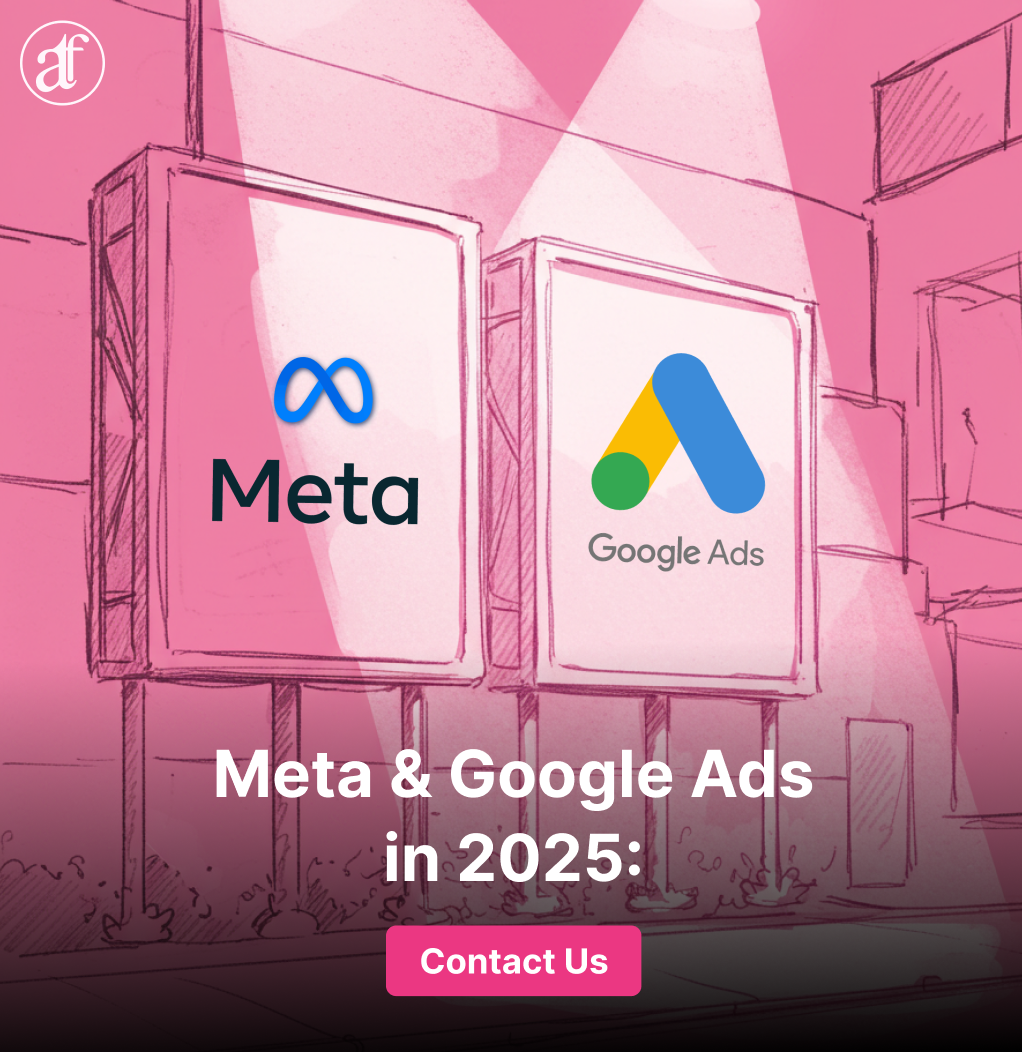
Meta & Google Ads in 2025: Strategies That Are Working Right Now
The digital advertising landscape has undergone a seismic shift in 2025, with artificial intelligence, privacy regulations, and evolving consumer behaviors reshaping how brands connect with their audiences. As competition intensifies across Google and Meta platforms, advertisers who adapt to these changes are seeing remarkable results, while those clinging to outdated strategies are watching their ROI plummet.
This comprehensive guide reveals the cutting-edge strategies that are driving success on Google Ads and Meta platforms right now. From leveraging AI-powered automation to mastering new ad formats on Threads, these proven tactics will help you stay ahead of the competition and maximize your advertising investment in 2025.
The New Reality of Digital Advertising in 2025
The advertising ecosystem has fundamentally changed. Traditional manual optimization techniques are becoming obsolete as platforms increasingly rely on machine learning to deliver results. Successful advertisers are embracing this shift, allowing AI to handle optimization while focusing their expertise on strategic planning and creative excellence.
Consumer behavior has also evolved significantly. Users are more privacy-conscious, ad-savvy, and selective about the content they engage with. This means advertisers must deliver highly relevant, valuable experiences that resonate with their target audience’s specific needs and preferences.
Google Ads Strategies That Are Winning in 2025
1. AI-Powered Campaign Optimization
Google’s advertising platform has become increasingly sophisticated in 2025, with AI playing a central role in campaign performance. The most successful advertisers are embracing automated bidding strategies and letting Google’s machine learning algorithms handle real-time optimization decisions.
Smart Bidding Strategies to Implement:
- Target CPA (Cost Per Acquisition) for businesses with established conversion tracking
- Target ROAS (Return on Ad Spend) for e-commerce campaigns with clear revenue goals
- Maximize Conversions for lead generation campaigns with sufficient data
The key is providing Google’s AI with high-quality conversion data. Ensure your conversion tracking is comprehensive, capturing not just direct sales but also meaningful micro-conversions like email signups, phone calls, and form submissions.
2. Audience-Intent Segmentation
One of the most effective Google Ads strategies in 2025 involves segmenting campaigns based on user intent rather than traditional demographic targeting. This approach recognizes that purchase intent varies significantly throughout the customer journey.
Intent-Based Campaign Structure:
- High-Intent Campaigns: Target users searching for specific products or ready-to-buy keywords
- Research-Intent Campaigns: Focus on informational queries and problem-solving searches
- Brand-Awareness Campaigns: Reach users early in their journey with broader, category-related terms
This segmentation allows for more precise messaging, budget allocation, and bidding strategies tailored to where users are in their decision-making process.
3. Dynamic Creative Optimization
Static ad creative is no longer sufficient in 2025’s competitive landscape. Google’s dynamic creative features allow advertisers to automatically test and optimize multiple combinations of headlines, descriptions, and visual elements.
Implementation Best Practices:
- Create 8-15 unique headlines that address different value propositions
- Develop 3-5 descriptions that complement various headline combinations
- Use responsive search ads as your primary ad format
- Regularly refresh creative assets to prevent ad fatigue
4. Landing Page Experience Integration
Google’s Quality Score algorithm has become more sophisticated in evaluating the entire user experience, from ad click to conversion. Successful campaigns in 2025 prioritize landing page optimization as much as ad creative.
Essential Landing Page Elements:
- Mobile-first design with fast loading times (under 3 seconds)
- Clear navigation pathways to key destinations
- Consistent messaging between ads and landing page content
- Multiple conversion opportunities without being overwhelming
- Social proof and trust signals prominently displayed
5. Budget Strategy Refinement
Effective budget management in 2025 requires a nuanced approach that accounts for seasonal fluctuations, competitive dynamics, and performance variations across different campaign types.
Advanced Budget Tactics:
- Implement dayparting to maximize budget efficiency during peak performance hours
- Use portfolio bidding to share budgets across related campaigns
- Allocate higher budgets to high-performing audience segments
- Reserve 20-30% of total budget for testing new keywords and audiences
Meta Ads Strategies Driving Results in 2025
1. Advantage+ Campaign Utilization
Meta’s Advantage+ suite represents the platform’s most significant advancement in automated campaign management. These AI-driven campaigns are consistently outperforming manual setups when properly configured.
Key Advantage+ Features to Leverage:
- Advantage+ Shopping Campaigns: Automatically optimize for e-commerce conversions across all Meta placements
- Advantage+ App Campaigns: Streamline app install and engagement campaigns
- Advantage+ Placements: Allow Meta to automatically select optimal ad placements across Facebook, Instagram, Messenger, and Audience Network
The success of Advantage+ campaigns depends on providing Meta’s algorithm with comprehensive conversion data and allowing sufficient learning time before making major adjustments.
2. Creative Quality Over Quantity Focus
Meta’s algorithm increasingly prioritizes ad creative quality over targeting precision. The most successful campaigns in 2025 invest heavily in producing thumb-stopping creative that resonates with their audience.
Creative Best Practices for 2025:
- Produce native-style content that feels organic to each platform
- Use authentic user-generated content and customer testimonials
- Create platform-specific variations (Instagram Stories vs. Facebook Feed)
- Test multiple creative formats: video, carousel, single image, and collection ads
- Implement Meta’s Creative Hub for collaborative creative development
3. Lead Quality Optimisation
Rather than maximizing lead volume, successful Meta advertisers in 2025 focus on lead quality metrics. This approach reduces cost per qualified lead and improves overall campaign ROI.
Quality-Focused Strategies:
- Use lead scoring to identify high-value prospects
- Implement multi-step lead forms to filter out low-intent users
- Create custom audiences based on lead quality rather than quantity
- Develop nurture sequences specifically for social media leads
- Track lifetime value, not just immediate conversions
4. Multi-Platform Integration
Meta’s expanded ecosystem now includes Threads, creating new opportunities for comprehensive social media advertising strategies. Successful campaigns coordinate messaging across all Meta platforms while respecting each platform’s unique user behavior.
Platform-Specific Approaches:
- Facebook: Focus on detailed targeting and longer-form content
- Instagram: Emphasize visual storytelling and influencer partnerships
- Threads: Test conversational, community-focused content
- Messenger: Implement chatbot integration for immediate response
5. Privacy-First Attribution
With ongoing changes to privacy affecting tracking capabilities, successful Meta advertisers are implementing first-party data strategies and server-side tracking solutions.
Attribution Optimisation Tactics:
- Implement Conversions API for server-side tracking
- Use first-party data for custom audience creation
- Focus on incrementality testing rather than last-click attribution
- Develop unified customer profiles across all touchpoints
Cross-Platform Strategy Integration
1. Unified Customer Journey Mapping
The most successful advertisers in 2025 view Google and Meta not as competing platforms but as complementary touchpoints in a unified customer journey.
Integration Strategies:
- Use Google Ads for high-intent capture and Meta for awareness building
- Retarget Google searchers with social proof campaigns on Meta
- Create lookalike audiences on Meta based on Google Ads converters
- Coordinate messaging themes across both platforms
2. Budget Allocation Optimisation
Effective cross-platform budget management requires understanding each platform’s strengths and optimising allocation based on customer lifetime value, not just initial conversion costs.
Budget Distribution Framework:
- Allocate 60-70% to your highest-performing platform initially
- Reserve 20-30% for testing and expansion
- Adjust allocation based on full-funnel metrics, not just first-touch attribution
- Consider seasonal patterns and competitive dynamics
3. Data Synchronization
Creating a unified view of campaign performance across Google and Meta requires sophisticated data integration and analysis capabilities.
Essential Metrics to Track:
- Cross-platform customer acquisition cost
- Unified attribution modeling
- Customer lifetime value by acquisition channel
- Brand awareness impact across platforms
Advanced Tactics for 2025 Success
1. AI-Powered Creative Generation
Leading advertisers are experimenting with AI tools to generate and test creative variations at scale, allowing for rapid iteration and optimization.
2. Voice Search Optimization
As voice search continues growing, successful Google Ads campaigns are incorporating conversational keywords and question-based targeting.
3. Augmented Reality Integration
Meta’s AR ad formats are creating new opportunities for immersive brand experiences, particularly effective for retail and lifestyle brands.
4. Micro-Moment Targeting
Both platforms are enabling more precise targeting of specific micro-moments in the customer journey, allowing for hyper-relevant messaging.
Common Mistakes to Avoid in 2025
Google Ads Pitfalls:
- Over-relying on exact match keywords without considering user intent
- Ignoring mobile-specific optimisations and user experience
- Setting unrealistic Quality Score expectations without proper landing page optimisation
- Manual bidding when automated strategies would perform better
Meta Ads Mistakes:
- Manually selecting placements instead of using Advantage+ options
- Focusing solely on reach metrics without considering engagement quality
- Neglecting creative refresh schedules leads to ad fatigue
- Inadequate conversion tracking setup is limiting algorithm optimization
KPIs That Matter in 2025
Primary Performance Indicators
- Customer Lifetime Value (CLV) by acquisition channel
- Incremental revenue attribution across platforms
- Quality Score improvements and their impact on costs
- Brand awareness lift from coordinated campaigns
Secondary Metrics
- Cross-platform conversion paths and attribution
- Creative performance by audience segment
- Budget efficiency across different campaign types
- Competitive share of voice changes
Preparing for Continued Evolution
The advertising landscape will continue evolving rapidly throughout 2025 and beyond. Successful advertisers are building flexible, data-driven strategies that can adapt to platform changes, privacy regulations, and shifting consumer behaviors.
Future-Proofing Strategies:
- Invest in first-party data collection and customer relationship building
- Develop platform-agnostic creative and messaging frameworks
- Build internal capabilities for AI-assisted campaign management
- Create comprehensive testing protocols for new features and formats
Conclusion
Success with Google Ads and Meta advertising in 2025 requires embracing AI-powered automation while maintaining strategic human oversight. The advertisers achieving the best results are those who understand that these platforms are most effective when used as part of an integrated, customer-centric approach.
By implementing the strategies outlined in this guide—from leveraging Advantage+ campaigns on Meta to embracing Smart Bidding on Google—you’ll be positioned to thrive in the evolving digital advertising landscape. Remember, the key is not just to follow best practices but to continuously test, learn, and adapt your approach based on your specific audience and business objectives.
The future belongs to advertisers who can balance automation with creativity, data with intuition, and platform-specific tactics with unified customer experience design. Start implementing these strategies today, and you’ll be ahead of the curve as digital advertising continues its rapid evolution.





